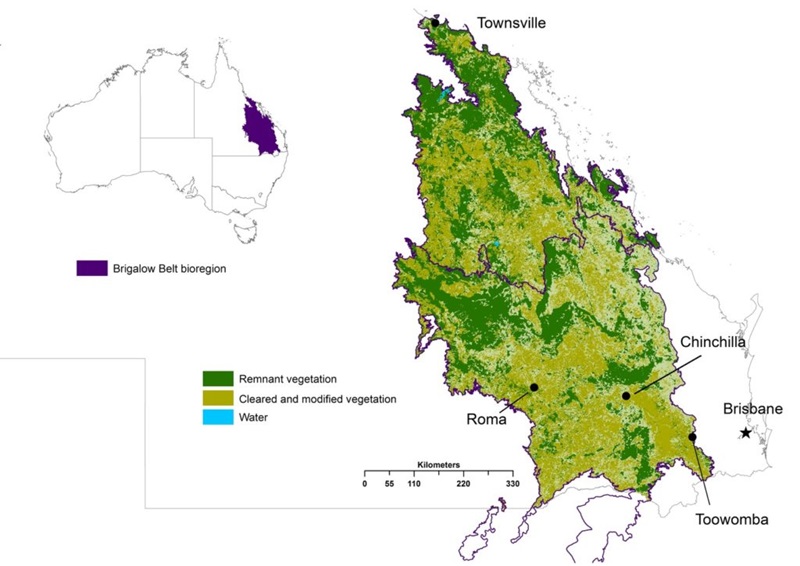Exploring Vegetation Across Climatic Conditions and Soil Profiles of Brigalow Communities


Gardening and landscape design offer a fascinating lens through which to explore the relationship between plants, climate, and soil. As gardeners, understanding how vegetation responds to these factors can guide us in making choices that not only enhance our outdoor spaces but also support ecosystems. Having examined semi-arid landscapes and begun to delve into subtropical zones, today we take a closer look at Brigalow (Acacia harpophylla) communities—a unique and vital component of Australia's flora.
The Brigalow Belt: A Distinctive Ecosystem
The Brigalow Belt is a bioregion spanning parts of Queensland and New South Wales. Named after the iconic Brigalow tree, this ecosystem is defined by a blend of semi-arid and subtropical influences. The Brigalow tree itself is a medium-sized, drought-resistant acacia with silvery-grey foliage and creamy-yellow flower spikes. It thrives in clay soils, particularly vertisols, which are prone to cracking and swelling as moisture levels fluctuate.
Climate and Soil Interplay
The Brigalow Belt experiences a mix of summer rainfall and dry winters, making it distinct from purely semi-arid or subtropical regions. The soils here are typically heavy, alkaline clays that pose challenges for water penetration and root development yet are rich in nutrients such as calcium and magnesium. These conditions create a specialised niche for plants like Brigalow, which have evolved to manage these soil dynamics.
Brigalow trees are pioneering species in this landscape, improving soil structure by contributing organic matter and fostering microhabitats for insects, fungi, and other organisms.
Plant Communities in Brigalow Ecosystems
Brigalow ecosystems host a range of plants that thrive under similar conditions, often forming woodlands with diverse understorey vegetation. Common species include:
Poplar Box (Eucalyptus populnea): Another tree well-suited to clay soils, often found alongside Brigalow.
Belah (Casuarina cristata): A nitrogen-fixing companion that enhances soil health.
Native Grasses and Forbs: Species such as Mitchell Grass (Astrebla spp.) provide ground cover and forage for wildlife.
Saltbush (Atriplex spp.): Found in low-lying areas, playing a role in managing soil salinity.
These communities contribute to carbon sequestration, biodiversity, and erosion control. However, agricultural clearing has significantly impacted the Brigalow Belt, threatening its delicate ecological balance.
Wildlife of the Brigalow Ecosystems
Brigalow woodlands are as remarkable for their wildlife as they are for their vegetation. These ecosystems support a wealth of animal species that depend on the habitat’s unique structure and resources.
Mammals
Bridled Nailtail Wallaby (Onychogalea fraenata)
This small wallaby, once thought extinct, relies on Brigalow habitats for shelter and protection from predators.Northern Hairy-nosed Wombat (Lasiorhinus krefftii)
Among Australia's most endangered mammals, it thrives in areas adjacent to Brigalow forests, where it can burrow in soft soils.Koala (Phascolarctos cinereus)
In transitional zones between Brigalow woodlands and eucalypt forests, koalas use Brigalow trees for shade and shelter.
Birds
Black-throated Finch (Poephila cincta)
This small bird favours the grasslands and woodlands of the Brigalow Belt, often nesting near Brigalow trees.Glossy Black-Cockatoo (Calyptorhynchus lathami)
Although more commonly associated with casuarinas, this striking cockatoo occasionally nests in Brigalow habitats.Red Goshawk (Erythrotriorchis radiatus)
One of Australia's rarest birds of prey, it hunts and nests in Brigalow areas, taking advantage of tall trees and abundant prey.
Reptiles and Amphibians
Golden-tailed Gecko (Strophurus taenicauda)
Found in Brigalow woodlands, this gecko uses its excellent camouflage to thrive in arboreal habitats.Yakka Skink (Egernia rugosa)
This vulnerable skink forages and burrows in Brigalow soils, depending on leaf litter and fallen logs.Brigalow Scaly-foot (Paradelma orientalis)
This legless lizard is unique to the Brigalow Belt and uses the habitat’s ground cover for protection.
Insects and Pollinators
Brigalow woodlands are teeming with insect life, including native bees that pollinate flowering plants and beetles that recycle organic material, enriching the soil.
Ecological Interactions
The interplay of plants and animals in Brigalow ecosystems demonstrates a harmonious and interdependent system.
Nectar-feeding Birds and Pollinators: Birds and insects pollinate Brigalow and its companion plants.
Seed Dispersal: Animals such as wallabies spread seeds, aiding regeneration.
Habitat Creation: Fallen branches and leaf litter provide shelter for reptiles and insects.
Gardening with Brigalow and Its Companions
For gardeners with heavy clay soils and a climate akin to the Brigalow Belt, incorporating plants from this ecosystem offers a way to replicate its resilience. Brigalow trees, while slow-growing, act as excellent windbreaks and soil improvers. Companion planting with hardy species like saltbush, Eremophila, and native grasses can emulate natural Brigalow woodlands.
Tips for Growing Brigalow:
Soil Preparation: Brigalow thrives in alkaline soils. Adjust pH with lime if necessary.
Drainage: Raised beds or well-draining soil are crucial to prevent waterlogging.
Propagation: Soak seeds in hot water to enhance germination.
Companion Plants: Pair Brigalow with drought-resistant shrubs and grasses for a thriving ecosystem.
Conserving Brigalow Landscapes
To protect Brigalow ecosystems, conservation efforts include habitat restoration, creating wildlife corridors, and controlling invasive species. Gardeners can contribute by mimicking Brigalow habitats in their gardens, providing shelter and resources for native wildlife.
The Brigalow Belt is a testament to nature's adaptability, offering valuable lessons in resilience. By celebrating and conserving its unique ecosystems, we can foster biodiversity and sustainability both in the wild and within our gardens.
